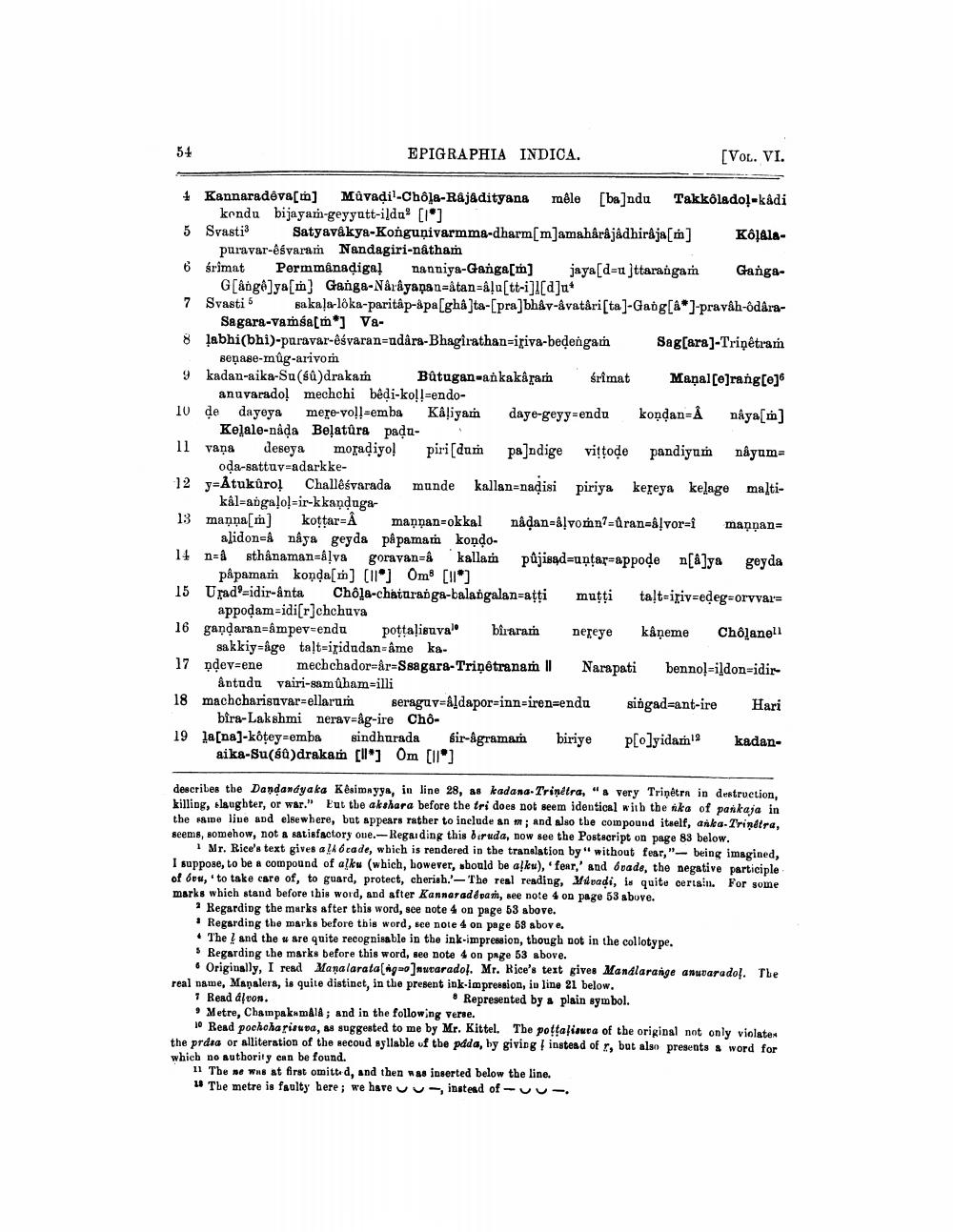________________
EPIGRAPHIA INDICA.
[VOL. VI.
4 Kannaradêve[m] Mûvadil-Chôļa-Râjâdityana mêle [ba]ndu Takkôladol-kadi
kendu bijayam-geyyatt-ilda[] 5 Svasti Satyavákya-Konguņivarmma-dharm[m]amahârâjâdhiraja[m] Ko Ala
puravar-ośvaram Nandagiri-natham 6 srimat Permmånadiga! nanniya-Ganga[m] jaya[d=u jttarangan Ganga
G[âög@]ya[m] Ganga-Narayanan=åtan=&!u[tt-i]][d]u* 7 Svasti sakaļa-loka-paritâp-&pa[ghâ]ta-(pra]bhav-avatari[ta]-Gadg[&]-pravåh-ôdâra
Sagara-vamsa[m] Va8 labhi(bhi)-paravar-êśvaran-adâra-Bhagirathan-iriva-bedengan Sag(ara)-Triņétram
Beñase-mug-arivom 9 kadan-aika-Su(sa)drakam Batugan-ankakaram Srimat
anuvarado mechchi bêdi-ko!l-endo10 de dayeya mere-voll-emba Kaliyam daye-geyy=endo kondan=ả nảya[m]
Kelale-nåda Beļatūra paduIl vaņa desoya mosadiyo! piri[dum pa]ndige vittode pandiyum nâyum=
oda-sattuy=adarkke12 y=Ảtukůro! Challēśvarada munde kallan=nadisi piriya kereya kelage multi
kâl=angaļo!=ir-kkaņduga13 manna[m] kottar=Â mannan-okkal nådan=&!vořni-uran=&ļvor=í maņpan=
alidon naya geyda papamam kondo14 n=8 sthậnaman=&!va goravan= kalla pûjisad=untar=appoden[@]ya geyda
påpamam konda[m] [ilo] Om [11] 15 Urade-idir-ånta Chôle-chaiuranga-balangalan=ațți mutti talt=iivedeg=orvvar=
appodam=idi[r]chchuva 16 gandaran=&mpev=enda pottaļisuval biraram nereye kâņeme Chộlanell
sakkiy-age taltiridadan-âme ka. 17 ndev=ene mechchador=&r=Ssagara-Trinetranam | Narapati bennol=ildon=idir
&ntadu vairi-samûham=illi 18 machcharisuvarrellarum seraguv=&ldapor-inn-irenzenda singad=ant-ire Hari
bira-Lakshmi nerav=&g-ire Chô19 1a[na]-köțey=emba sindhurada bir-&gramam biriye p [O]yidan!
kadanaika-Su(sa) drakam [ll] Om (II)
describes the Dandandyaka Kesimayya, in line 28, as kadang-Trinitra, "& very Trinetra in destruction, killing, slaughter, or war." Eut the akshara before the tri does not seem identical with the ska of paskaja in the same live and elsewhere, but appears rather to include anm; and also the compound itself, anka-Trimetra, seems, somehow, not a satisfactory oue.-Regarding this biruda, now see the Postscript on page 83 below.
Mr. Rice's text gives allocade, which is rendered in the translation by" without fear, "-being imagined, I suppose, to be a compound of alku (which, however, should be asku), fear,' and Ovade, the negative participle of buu,' to take care of, to guard, protect, cherish.' - The real reading, Mdadi, is quite certain. For some marks which stand before this word, and after Kannaradepan, see note 4 on page 53 above.
- Regarding the marks after this word, see note 4 on page 53 above.
Regarding the marks before tbis word, sce note 4 on page 58 above. • The ! and the ware quite recognisable in the ink-impression, though not in the collotype.
Regarding the marks before this word, see note 4 on page 53 above.
• Originally, I read Manalarata ago ]nwaradol. Mr. Rice's text gives Mandlarange anuvaradol. The real name, Manalera, is quite distinct, in the present ink-impression, in line 21 below. 7 Read áļvon.
Represented by a plain symbol. • Metre, Champak mald; and in the following verse.
10 Read pochoharisuna, as suggested to me by Mr. Kittel. The potrafisura of the original not only violates the prdia or alliteration of the secoud syllable of the páda, by giving instead of , but also presents a word for whicb no authority can be found.
11 The me was at first omitted, and then was inserted below the line. 1 The metre is faulty bere; we have instead of -vu




